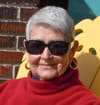The Challenge: Primary Biliary Cirrhosis
In 1980, Susan Sher made a fateful deal with her husband, Dr. Stephan Sher. Concerned about his health, she told him that if he went for a complete physical, she would as well.
Although Stephan was fine, doctors discovered that Susan had a life-threatening condition.
“I was put in the hospital and they did a liver biopsy. They diagnosed me with primary biliary cirrhosis,” Susan remembers.
Primary biliary cirrhosis is an autoimmune disease in which the immune system attacks bile ducts in the liver. As the ducts become damaged over time, bile builds up in the liver, eventually causing it to fail.
“There’s no treatment,” says Susan. “You get very itchy. You can go out of your mind with the itchiness. You turn yellow because your body can’t get rid of the bile. I was diagnosed when I was 43 years old. It’s a horrible disease. The ammonia levels in your brain get high, and I was not myself at all. The hepatologist said I was going to die.”
The Path to UPMC: Meeting Dr. Starzl
Desperate, Susan’s husband began to do some research on options.
"A little girl in New Jersey had just had a liver transplant. Dr. Starzl, who had performed it, happened to be coming to Allentown to give a talk. My husband went to hear him. We had nothing to lose.”
Susan’s hepatologist, however, was dubious of the idea of liver transplants.
“It was so new that my doctor said it was just grandstanding. Thank goodness for Stephan. If he weren’t a doctor, I would not be alive today.”
With the help of Thelma Thiel, founder of the American Liver Foundation, Stephan was invited to Washington, D.C. to meet with Surgeon General C. Everett Koop, Dr. Starzl, and others.
He was invited as a family physician, as well as the spouse of someone with end stage liver disease. It was March of 1982. At that time, Stephan had an opportunity to speak with Dr. Starzl, who arranged for Susan to come to Pittsburgh for a work up.
The Solution: "Your Typical Garden-variety Transplant"
After testing, doctors at UPMC felt that Susan needed a liver transplant.
“In June, they offered me a liver,” she says. “I wasn’t ready psychologically, and I refused it. Then I got scared. I thought they might not offer again.”
In the next months, Susan’s health grew progressively worse.
“By September, I weighed 95 pounds, my stomach was distended, and my skin was yellow.”
She and her husband called Starzl, who said to come to Pittsburgh, and he would have a liver in a week.
That’s exactly how long Susan waited in the hospital.
“Then, all of a sudden, they started prepping me for surgery. I was so ecstatic, I literally jumped onto the table.”
The surgery lasted 12 hours. Susan’s husband, children, and brother-in-law were there when she woke up.
“The yellow was gone. I wasn’t itchy. All the poison had come out of me. It was absolutely amazing. I felt like my new liver was doing exactly what it was supposed to do.”
Susan was in the hospital for four weeks. A few days after her surgery, Dr. Starzl looked at her daily blood test and casually remarked, "just your typical garden-variety transplant."
And Susan knew she was going to be all right.
She was given cyclosporine, an antirejection drug that was still experimental at the time. Then she and her husband went home to Allentown.
Of course, Susan traveled back to Pittsburgh regularly for medication adjustments and liver biopsies.
But a highlight of her transplant experience came in 1983.
“The day cyclosporine was approved, I was on The Today Show with Dr. Starzl and Dr. Borel, who discovered cyclosporine. It was interesting. It struck me that I was there with the two men who saved my life.”
The Results: Enjoying Family and Retirement
After her transplant, Susan’s life got back to normal very quickly. In a few weeks, she returned to her job as an office manager in her husband’s practice.
Today, Susan has lived to see her daughter get married and have children, and to see her son become a doctor and a father, as well.
“Now I’m retired. I read a lot. I walk a lot. My husband and I enjoy being with each other. I’m still very happy to be alive.”
She also keeps in touch with the people who changed her life.
“I write to Dr. Starzl every year on the anniversary of my transplant. He always writes back. I also write to the doctor who took care of me medically, and to my transplant coordinator, Sandra Stachak-Chico, who’s now in charge of development at the Starzl Transplant Institute.”
Susan muses, “I used to think if I could only have one normal day, I’d be happy. Now it’s been 28 years.”
Susan’s treatment and results may not be representative of all similar cases.
Learn More About Liver Transplant
UPMC Health Library:
UPMC Liver Cancer Center:

















